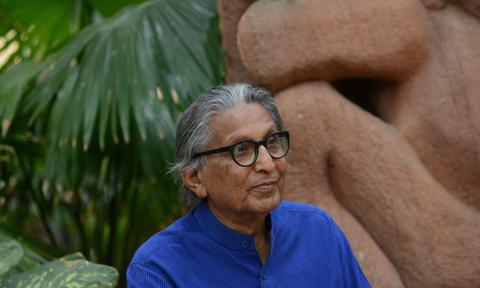
When Balkrishna Vithaldas Doshi speaks of architectural structures, he personifies them into beings with a life of their own. Though it wouldn’t be far off the mark to say that this veteran architect breathes life into the spaces he designs. In a career spanning seven decades and over 100 projects, Doshi is credited with steering Indian architecture down its current path of unfaltering creativity, having worked with some of the greatest names of all time in the field, including Louis Kahn and Le Corbusier. The first Indian to win the Pritzker Prize (2018) — considered the Oscar of architecture — and the winner of both the Padma Shri and Padma Bhushan, Doshi’s most recent feather in his meritorious cap, at 94 years of age, was the Royal Gold Medal 2022, the highest honour for architecture. With this, he came full circle, given how the win brought back memories of his time working with his mentor in 1953, when Le Corbusier had won the medal.
READ: Celebrity Architect Ashiesh Shah Gets Candid About His Journey
Known to have coined the term ‘purposeful architecture’ through his works, Doshi is an original, independent thinker and the creative genius behind some of Ahmedabad’s most iconic structures, including Amdavad ni Gufa, the Atira Guest House, Ahmedabad School of Architecture (renamed CEPT University in 2002), the Institute of Indology, and Tagore Memorial Hall. IIM- Bangalore, too, was his work of art. His buildings bring together pioneering modernism with the vernacular, infused with his deep appreciation for the traditions of India’s architecture, climate, culture, and craft. Besides administrative and cultural facilities, housing developments and residential buildings, he’s known globally for his visionary urban planning and social housing projects, in addition to his work in education.

HELLO!: A few years ago, you had said ‘architecture is an extension of life’. Could you please elaborate on this statement?
BV: Architecture talks about not just buildings but the society and environment. So if we keep our eyes and ears open, we will see the life that goes on in and around the structures we build. That’s where our answer to architecture as an extension of life is. So for an architect to talk about buildings, a society, or the environment... if he’s fully involved with what’s before his eyes, then we get the answer.
HELLO!: No stranger to awards and accolades, how did you feel when you learnt about the Royal Gold Medal?
BV: I almost felt like a child in a magical world. I had never thought that I would get the Royal Gold Medal, so it was beyond my imagination. It was very humbling.
HELLO!: How do you typically envision a project when starting out? From balancing inventiveness with functionality, keeping things familiar yet surprising…
BV: There’s something resembling a theatre in my mind. For me, everything I see, think of, or imagine is alive and living. So while working on a project, I revisit the images in my mind, where I felt a sense of attachment. I go back in time and experience these moments in my mind’s eye visually, physically, and emotionally.
HELLO!: What are the most drastic changes in architecture you’ve noticed?
BV: In earlier times, the love for architecture, space, form, light, and ways of living was like storytelling. Today, there are times when I sense it’s become quite functional and analytical. The immeasurable mystery and magic is slowly disappearing. Those fleeting moments of surprise in architecture are what I miss.

HELLO!: On the other hand, what elements of architecture would you say have survived?
BV: The fluidity and ephemerality of space as well as the enchanting character of space and form still exist. That is the beauty of architecture.

HELLO!: Any favourites among all your architectural marvels?
BV: Among my work, it’d be Amdavad ni Gufa. It was like a dream that manifested into the built form. For me, it was like a child’s play devoid of any analysis or justifications — quite like a meal you enjoy, relish, and carry with you in your memory. Moreover, it was an homage to artist and my friend MF Husain, who was constantly reinventing himself.
HELLO!: You once beautifully said Le Corbusier’s buildings ‘sing’ and Kahn’s are for meditation. Could you elaborate?
BV: The spaces in Le Corbusier’s buildings are romantic, lyrical and fleeting. When you move there quietly, the play of volumes, light and space is very different from the way you’d experience the spaces in Kahn’s buildings, which are a play of light, shadow and space in silence.
HELLO!: Tell us a little about your studio, Sangath.
BV: Sangath means ‘moving together’. We are a family of architects, and each one, like the five fingers of our hand, is different and complements the other. It’s the coming together of varied ways of seeing and doing things and finding varied interpretations while remaining cohesive in our fundamental search together.
HELLO!: Your words of advice to budding architects trying to make their way in the design world.
BV: Be yourself, look deep inside, find your hauntings, reconnect with your memories, reimagine those spaces and catch those subtle nuances of the space.
Photo Courtesy: Balkrishna Doshi Archives, Vastu Shilpa Foundation
Do you love reading about interiors and are on a constant lookout for expert advice? In our July issue, we are celebrating the top architects and interior designers of the industry to give you an insight into their world along with an inspirational guide to spruce up your homes. Get your hands on the latest issue right here!
This has been adapted for the website from a story that was originally published in Hello! India’s July 2022 issue.
- Quick links
- designers
- Interiors
- Architecture
- Architect






